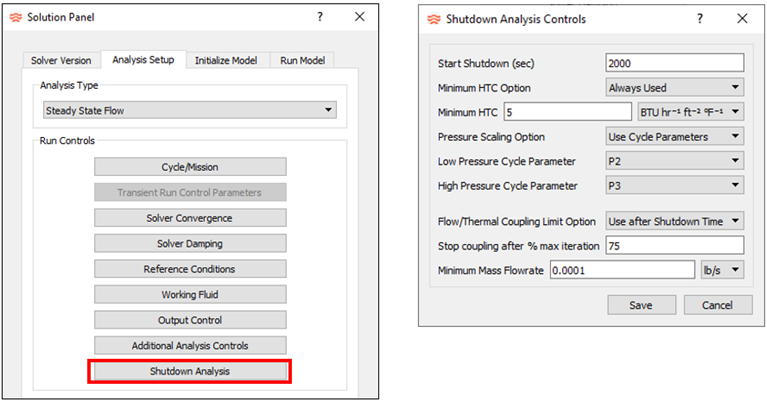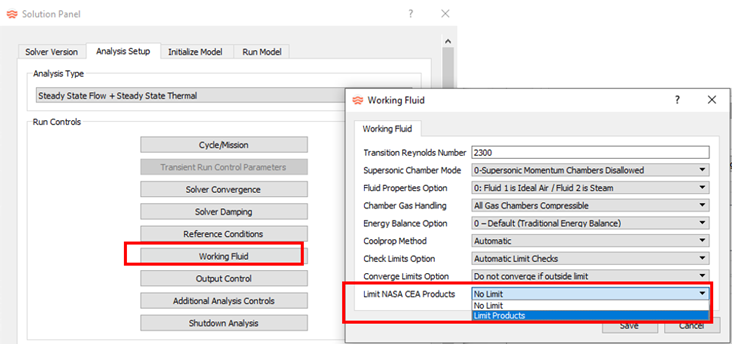Altair Flow Simulator 2023 Release Notes
Highlights
- More Heat Transfer Coefficient correlations.
- Functional Mock-up Unit (FMU) Export (BETA).
- Shutdown (low power at end of transient) Logic (BETA).
New Features
- More Heat Transfer Coefficient Correlations
- Eight additional HTC correlations are available to use with convection resistors in the thermal network. Use these new correlations for convectors not associated with a tube element.
- Functional Mock-up Unit (FMU) Export (BETA)
- You can export an FMU from the GUI and use it with another program (for
example, Altair Activate) that can import an FMU for solver coupling.
The FMU is based on the Functional Mock-up Interface (FMI) version 2.0.
The FMU contains the Flow Simulator model and
an XML file that contains a list of input and output variables. Use the
FMU to run the Flow Simulator model in steady
state or transient. This feature is considered a BETA release as more
testing is needed with other FMU importers.
Figure 2. FMU Export 
- Shutdown (Low Power at End of Transient) Logic (BETA)
- The solver has “shutdown” logic to improve convergence during the very low power (and low pressure) conditions at the end of a transient mission for a gas turbine. Shutdown logic is applied after a user-defined shutdown time. The shutdown logic converts most elements to fixed flow elements to maintain the percent core flow for each element. Chamber pressures are scaled with cycle or boundary pressures. You can also set a minimum heat transfer coefficient. Use the minimum HTC for the entire transient, if needed.
Enhancements
- Add Resistor Area Multiplier
- An area multiplier option has been added to the three types of thermal
resistors (conductor, convector, and radiator). The “AUTO” setting for
the area multiplier automatically accounts for a tube element
multiplicity factor by setting the area multiplier to the multiplicity
factor on resistors that are in a series with the associated convector.
For example, the area multiplier = 1.0 if the element’s multiplicity
factor = 1.0. The area multiplier can also be used for any purpose where
a heat flow multiplier is needed (like additional area due to fins). The
area multiplier is multiplied by the area in the resistor's heat flow
equation.
Figure 4. Thermal Resistor Area Multiplier 
- Plotting Results Difference Improvements
- In the GUI, the function has been improved. You can plot color contours
of the differences for several variables.
Figure 5. Results Comparison 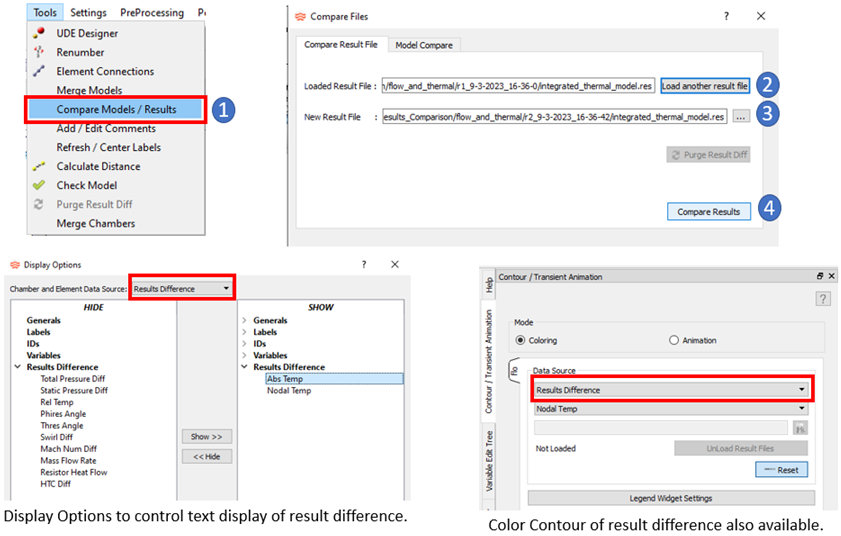
- NASA CEA Reaction Control
- NASA CEA can return unexpected fluid properties for certain species. For instance, if ammonia (NH3) is sent to NASA CEA with a specified temperature and pressure, CEA returns properties for a mixture of NH3, H2, and N2. The properties can be significantly different than the properties for pure NH3. A new control option is now available to limit the species considered in the CEA equilibrium calculation. If the Limit Products option is used, CEA only considers the species received (that is, NH3 remains NH3).
- Labyrinth Seal Pocket Chambers
- Vortex chambers can now be associated with labyrinth seal pocket
chambers. This is useful for post-processing and including the pocket
temperatures in the thermal network. Display pocket pressures,
temperature, and swirls along with the other chamber results. A
convector attached to the pocket vortex chamber is an easy way to
include the pocket temperatures in the thermal network.
Figure 7. Labyrinth Seal Pocket Chambers 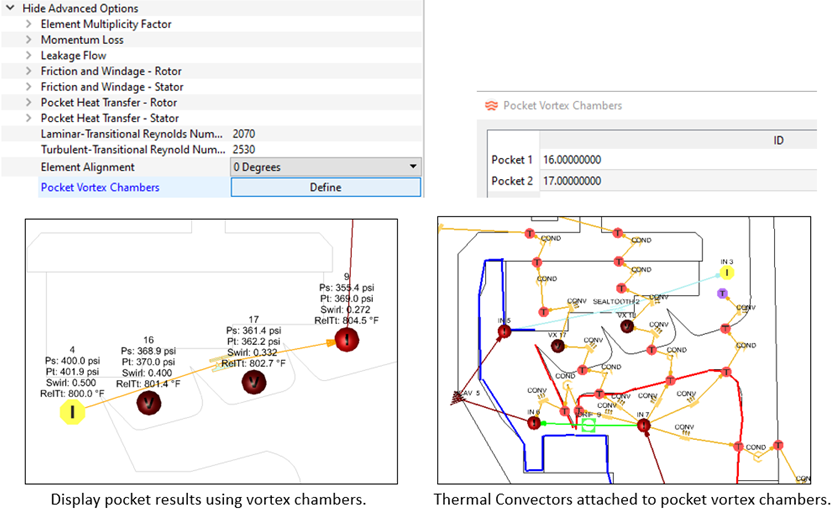
- Unit Options for Analysis Setup Inputs
- Several inputs in the Analysis Setup panel now have unit options. For
instance, flow rate convergence criteria can now be set in kg/sec, or a
cycle flow can be set using kg/sec.
Figure 8. Units Options for Analysis Setup Inputs 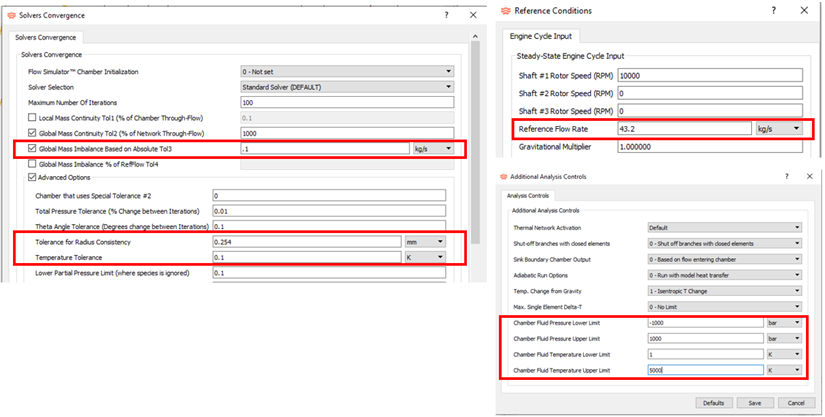
- Friction for Two-phase Flow in the Incompressible Tube Element
- The incompressible tube element has a new friction factor option for
two-phase flow. Previous versions used the homogenous approach where
fluid properties of the two-phase fluid are used in the friction
equations for a single phase. The two-phase friction correlation
developed by Friedel have been added.
Figure 9. Friction Factor for Two-phase Flow in the Incompressible Tube 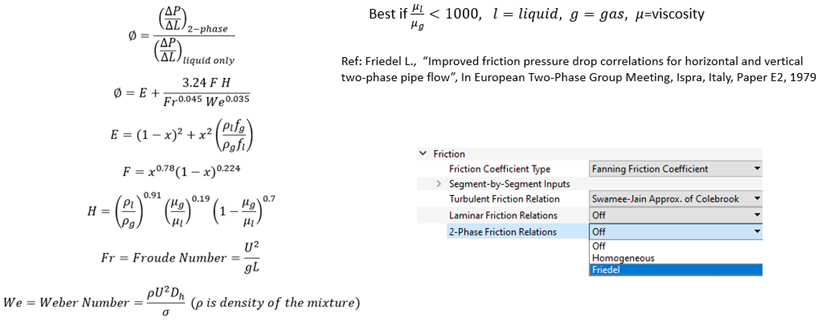
Known Issues
The following known issues will be addressed in a future release as we continuously
improve software performance:
- The controller interface does not work with controllers that have two relations (For example: 1D table and a Python script in the same controller).
Resolved Issues
- Improved coupling of Advanced Tube and Incompressible Tube elements to thermal network convectors. Convectors now use a fluid temperature equivalent to a log mean temperature difference. Temperature results change if elements have large temperature increases and few stations.
- Fixed Labyrinth Seal (both Vermes and Tooth-by-Tooth) land rotation effects on swirl and temperature change. Only changes result if the land (side of seal without teeth) is rotating.
- Fixed Labyrinth Seal (both Vermes and Tooth-by-Tooth) temperature rise limit. The automatic temperature rise limit may have been too low for seals with many teeth (>~20). This has no affect on results for seals with moderate temperature rise.
- Fixed problem with a custom heat load applied to an Advanced Tube or Incompressible Tube. Flow Simulator now writes the proper line to the *.flo file. No effect on solver results.
- Multi-edit items fixed in the GUI. For instance, changing the units for many elements at once is now possible.
- The Autofill option of the cavity flows tab now fills the radii column correctly for labyrinth seals and FI Cdcomp elements with an exit radius different than the inlet radius.
- Fixed problem with units for tables that have more than 10 rows.
- Added missing “HTC Entrance Adder” input to the Advanced Tube element.
- Added some missing items from the model Import/Export file.
- Added missing results display items for some elements (For example: exit Mach Number for transition elements).
- Coolprop updated to the latest version (6.4.3). This is not expected to create any results differences.

